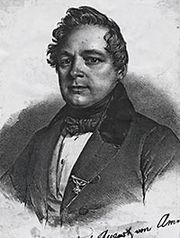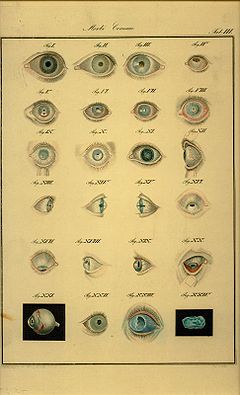
Friedrich August von Ammon
Encyclopedia

Göttingen
Göttingen is a university town in Lower Saxony, Germany. It is the capital of the district of Göttingen. The Leine river runs through the town. In 2006 the population was 129,686.-General information:...
. He studied medicine at the Universities of Göttingen and Leipzig
University of Leipzig
The University of Leipzig , located in Leipzig in the Free State of Saxony, Germany, is one of the oldest universities in the world and the second-oldest university in Germany...
, and in 1829 became a professor of clinical medicine and surgery
Surgery
Surgery is an ancient medical specialty that uses operative manual and instrumental techniques on a patient to investigate and/or treat a pathological condition such as disease or injury, or to help improve bodily function or appearance.An act of performing surgery may be called a surgical...
in Dresden
Dresden
Dresden is the capital city of the Free State of Saxony in Germany. It is situated in a valley on the River Elbe, near the Czech border. The Dresden conurbation is part of the Saxon Triangle metropolitan area....
. He was the son of theologian Christoph Friedrich von Ammon
Christoph Friedrich von Ammon
Christoph Friedrich von Ammon was a German theological writer and preacher.von Ammon was born at Bayreuth, Bavaria.He studied at Erlangen, held various professorships in the philosophical and theological faculties of Erlangen and Göttingen, succeeded Franz Volkmar Reinhard in 1813 as court...
(1766-1850).
Friedrich von Ammon is remembered for establishing Dresden
Dresden
Dresden is the capital city of the Free State of Saxony in Germany. It is situated in a valley on the River Elbe, near the Czech border. The Dresden conurbation is part of the Saxon Triangle metropolitan area....
as a major center of ophthalmology
Ophthalmology
Ophthalmology is the branch of medicine that deals with the anatomy, physiology and diseases of the eye. An ophthalmologist is a specialist in medical and surgical eye problems...
in the 19th century. His creation of a learning institute, his influential writings and his research of eye disorders were all important factors in this endeavor. He made contributions in the study of iritis
Iritis
Iritis is a form of anterior uveitis and refers to the inflammation of the iris of the eye.-Types:There are two main types of iritis: acute and chronic. They differ in numerous ways....
and sympathetic ophthalmia
Sympathetic ophthalmia
Sympathetic ophthalmia is a granulomatous uveitis of both eyes following trauma to one eye. It can leave the patient completely blind. Symptoms may develop from days to several years after a penetrating eye injury. See also the reviews by Damico et al. , Chu and Foster , and Friedlaender et al...
, and in 1830 founded Zeitschrift für die Ophthalmologie, an early journal devoted to ophthalmology. His best known monograph
Monograph
A monograph is a work of writing upon a single subject, usually by a single author.It is often a scholarly essay or learned treatise, and may be released in the manner of a book or journal article. It is by definition a single document that forms a complete text in itself...
is Klinische Darstellung der Krankheiten und Bildungsfehler des menschlichen Auges, which was known for its superb hand-colored illustrations and its detailed descriptions of congenital eye disorders. This atlas was considered the most comprehensive work regarding eye disease prior to the introduction of the ophthalmoscope by Hermann von Helmholtz
Hermann von Helmholtz
Hermann Ludwig Ferdinand von Helmholtz was a German physician and physicist who made significant contributions to several widely varied areas of modern science...
(1821-1894) in 1851.
In 1842 he published an important work on plastic surgery
Plastic surgery
Plastic surgery is a medical specialty concerned with the correction or restoration of form and function. Though cosmetic or aesthetic surgery is the best-known kind of plastic surgery, most plastic surgery is not cosmetic: plastic surgery includes many types of reconstructive surgery, hand...
titled Die plastische Chirurgie.
Selected writings

- De genesi et usu maculae luteae in retina oculi humani obviae (Weimar 1830)
- De physiologia tenotomiae (The Physiology of TenotomyTenotomyA tenotomy is a surgical act which involves the division of a tendon.When it involves the Achilles tendon, it is called a "Achillotenotomy".It has been used in the treatment of cerebral palsy.It has also been used for hammer toe....
) (Dresden. 1837) - Klinische Darstellung der Krankheiten und Bildungsfehler des menschlichen Auges etc. (Berlin 1838-47, 4 Bde.)
- Die Behandlung des Schielens durch den Muskelschnitt (Treatment of Squinting) (Berlin 1840)
- 'Klinische Darstellungen der Krankheiten und Bildungsfehler des menschlichen Auges (1838-1841)
- De Iritide (About IritisIritisIritis is a form of anterior uveitis and refers to the inflammation of the iris of the eye.-Types:There are two main types of iritis: acute and chronic. They differ in numerous ways....
) (deutsch, Berlin. 1843) - Illustrierte pathologische Anatomie der menschlichen Kornea, Sklera, Choroidea und des optischen Nerom (Illustrated Pathological Anatomy of the CorneaCorneaThe cornea is the transparent front part of the eye that covers the iris, pupil, and anterior chamber. Together with the lens, the cornea refracts light, with the cornea accounting for approximately two-thirds of the eye's total optical power. In humans, the refractive power of the cornea is...
, ScleraScleraThe sclera , also known as the white or white of the eye, is the opaque , fibrous, protective, outer layer of the eye containing collagen and elastic fiber. In the development of the embryo, the sclera is derived from the neural crest...
, ChoroidChoroidThe choroid, also known as the choroidea or choroid coat, is the vascular layer of the eye, containing connective tissue, and lying between the retina and the sclera. The human choroid is thickest at the far extreme rear of the eye , while in the outlying areas it narrows to 0.1 mm...
and the Optic NerveOptic NerveOptic Nerve may refer to:*Optic nerve, the anatomical structure*Optic Nerve , the comic book series*Optic Nerve , a Red Hot Benefit Series tribute to David Wojnarowicz...
) (hrsg. von Warnatz, Leipzig 1862) - Die angebornen chirurgischen Krankheiten des Menschen (Berlin. 1839-1842)
- Die plastische Chirurgie {Concerning Plastic Surgery) (with Moritz Baumgarten, Berlin. 1842)

